Nature Conservation 2025 — 31. 7. 2025 — Nature and Landscape Management — Print article in pdf
Ecologically Significant Elements (Landscape Elements) as Part of the Ecological Network
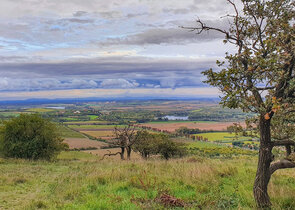
The Czech Republic’s ecological network consists of a system of large core areas (protected areas, biocentres) interconnected by linear ways or routes (biocorridors) or stepping stones. It is thus a spatial network of landscape elements ensuring the preservation or improvement of the state of species populations and habitats, and thereby the health of ecosystems, including the processes taking place in them. It essentially strengthens the resistance and resilience of the landscape structure, and the sustainability of renewable natural resources during ongoing climate change.
In the Czech Republic, nature conservation and landscape protection and land-use/territorial planning use a wide range of complementary tools used to establish and maintain the ecological network, however unfortunately often separately. The Czech Republic’s ecological network is shaped as a multi-layered system including the entire biological infrastructure, i.e. all areas of different protection levels and management types, from Specially Protected Areas to non-forest greenery. A large proportion of network segments overlap and perform multiple functions at the same time. They are often territories designated for the biodiversity conservation, natural water accumulation, buffer zones of natural mineral water and healing sources, protective forests, anti-erosion elements, and recreation areas or sites for holiday-making. The network must therefore be understood holistically, because it can only fulfil all its functions as a coherent network of mutually supporting elements. The total area of all ecological network elements covers 56% of the Czech Republic’s territory (Pešout & Hošek 2012).
The structure of the set of ecological stability elements is constantly changing in space and time. These changes may be both ecologically positive and negative and can be caused by human activities as well as natural processes. If these changes did not alter at least the initial state of the ecological skeleton of the landscape, one could speak with some satisfaction of ‘stability’. Unfortunately, the long-term trend is a worsening of this state (Petříček & Plesník 2012).
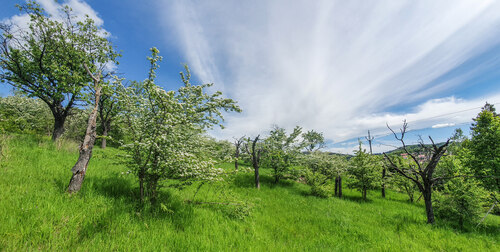
According to the Government Decree, Ecologically Significant Elements also include landscape orchards (in the photo: old orchard in Džbány-Žebrák Nature Park, Central Bohemia). Unlike other ESEs, these are non-productive areas and therefore, they are not tax-exempt. Support for their maintenance falls under the specific AECM (Agri-environment-climate Measures) subvention programme/subsidy scheme of the Common Agricultural Policy. © Pavel Pešout
What are Ecologically Significant Elements?
Act No. 252/1997 on Agriculture, as amended later, defines a part of the landscape elements in the agricultural landscape, i.e. non-forest greenery, rock outcrops, and wetlands, as the so-called Ecologically Significant Elements (ESEs). According to the Act, an ESE is a continuous area of non-agricultural land with non-productive functions, or another formation which is part of or immediately adjacent to agricultural land. Government Regulation No. 307/2014 [determining details of land use records according to user relations, as amended] defines the following ESE types: balks, terraces, grassy thalwegs, copses, allées, solitary trees, landscape orchards, ditches, wetlands, and rockeries (see Box 1). ESEs are registered by the National Agricultural and Intervention Fund (NAIF) at farmer’s request as part of the land- use register under the Agriculture Act in the Public Land Register (PLR)
[https://eagri.cz/public/app/lpisext/lpis/verejny2/plpis/].
NAIF registers ESEs if the landscape element is part of or directly adjacent to agricultural land. ESEs can be internal or external. An internal ESE must be completely surrounded by agricultural land registered in PLR (Gimunová et al. 2015). These are usually wetlands, stone mounds or various non-forest greenery elements, i.e. solitary trees and hedges in fields. Landscape elements not fully surrounded by registered farmland are regarded external ESEs. These may be allées or ditches on the margin of agricultural land or balks dividing a field or meadow.

A landscape element may also include an object of small sacral architecture – the village of Částrovice, Podblanicko Region (Central Bohemia). © Pavel Pešout
ESE protection
The Act does not explicitly imply any obligations for a farmer or landowner to protect ESEs. Thus, selected ESEs or parts of them can ‘only’ be protected with nature conservation instruments, particularly in the case of trees growing outside forests and habitats of Specially Protected Species. ESEs are, however, protected against damage or destruction as part of the basic conditions (Standards of Good Agricultural and Environmental Soil Conditions) which farmers must comply with to qualify for agricultural subsidies under the EU Common Agricultural Policy (CAP). The basic rules of cross-compliance are regulated by Government Decree No. 73/2023, establishing rules for cross-compliance of payments to farmers.
Farmers are not allowed to damage registered ESEs, but neither unregistered landscape elements located on PLR-registered land or in their vicinity which could theoretically be registered as ESE (i.e. meet the definition of one of the types of ESE).
Specifically, farmers have to protect ESEs by preventing them “from a reduction in acreage or damage to the vegetation or rock or stone cover of a landscape element, from drainage operations, soil stockpiling or storage of organic material, mechanically damage to the above- and belowground parts of trees, and application of fertilisers, plant protection agents, and treated sludge”. The conditions for wetlands and rockeries do not apply to interventions carried out with consent of the respective State Nature Conservanvy authority For details, see Methodological Manual for Cross-compliance https://eagri.cz/public/portal/-q304687---FFeG7cUk/metodicka-prirucka-pro-pravidla.
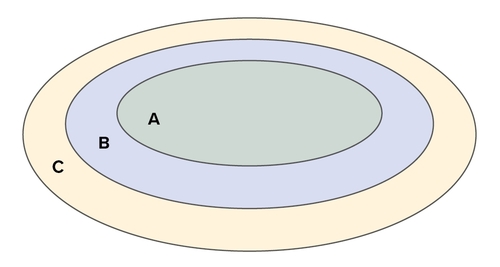
In the Czech Republic, a skeleton of the ecological network is formed by the Territorial System of Ecological Stability, multilevel ecological network sensu stricto (A) supplemented by protected areas of all categories and a part of the Ecologically Significant Elements (B). These elements, together with all other close-to-nature areas providing ecosystem services in the landscape, form the green infrastructure (C). © Pavel Pešout & Michael Hošek
ESE potential
ESEs are fundamentally different from established common nature conservation tools, i.e. particularly under the Territorial System of Ecological Stability (TSES) and Significant Landscape Elements (SLEs). Whereas constituent parts of the TSES and the SLEs (whether registered or the so-called ‘by law’) and their functions are subject to legal protection, ESEs lack such protection, as outlined above. Whereas constituent parts of the TSES are according to the methodology (Bínová et al. 2017) defined by authorised persons with high expertise and approved within the complex process of land-use/territorial or spatial planning, and SLEs are defined directly by the Act on Nature Conservation and Landscape Protection or registered by a State Nature Conservancy authority in an administrative procedure, an ESE is ‘simply’ registered at the NAIF ex officio or at the request of a farmer (or landowner or anyone else) after verification of its status in PLR (with an orthophotograph), rather exceptionally in the field. In the case of ESEs, targeted legal protection is thus missing, but they excel in simplicity and their registration being up to date. However, the greatest benefit of the ESEs is that, unlike the registration or approval of the designation of a TSES or SLEs constituent part, ESEs can be registered at the will of the landowner or farmer. Farmers are interested in registering ESEs to preserve a landscape element in the so-called managed area and then obtain all flat-rate/blanket subsidies (direct payments, agri-environmental-climate measures AECM, etc.). Another strong incentive for registering ESEs is property tax exemption. The potential of ESEs is thus considerable and will increase with the development of the instrument, which is currently discussed in a joint working group of the Ministry of Agriculture of the Czech Republic (MoA) and the Ministry of the Environment of the Czech Republic (MoE) (see below).
ESEs as part of the ecological network
Most of the ESEs consist of landscape elements which in the ecological network theory, particularly the Territorial System of Ecological Stability, can be classified as interactive elements. These are important near-natural wild plant and animal habitats. Their role is to support the interrelations between organisms in the landscape and between organisms and the environment they inhabit (Míchal & Petříček 1988). Typical interaction elements are traditionally transitional habitats of forest margins, hedgerows, copses, solitary trees in agricultural landscapes, small springs, communities on balks, stony substrates, and agrarian terraces, high-stem orchards, riparian vegetation, parks, and allées. They are usually isolated patches and are mostly smaller than TSES biocentres and biocorridors, to which they do not have to be connected, so that they create a finer landscape structure. Interactive elements are often managed as farmland. Their aesthetic value remains an accompanying but (from the landscape perspective) essential characteristic (Kasalický 2010).
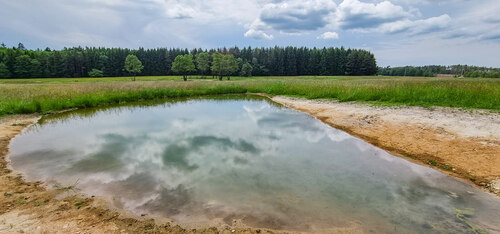
Various wetland types including pools with a minimum area of 100 m² can be registered as a non-productive ‘Wetland’ Ecologically Significant Element and thus, inter alia, apply for property tax exemption. © Pavel Pešout
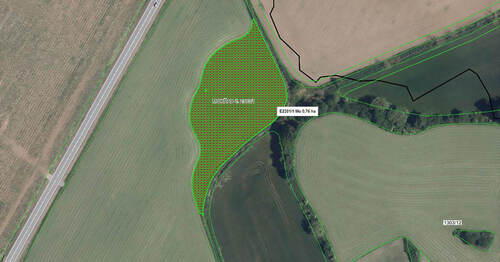
Example of an Ecologically Significant Element of the ‘Wetland’ type registered in spring 2024 at a site of inundated arable land near the town of Třebič (southwestern Moravia). The flooding happened through a rise in water level caused by Eurasian beavers (Castor fiber) damming a stream. Source Nature Conservation Agency of the Czech Republic
Interactive elements are not explicitly mentioned in any legal rules and do therefore – in contrast to biocentres and biocorridors – not have to be visualised in land-use/territorial or spatial plans. Regarding the striking coincidence of the list of typical interactive elements and ESE types, and the codification of this institute in agricultural legislation, interactive elements on farmland can be replaced by ESEs. Including them in the ecological network was already considered more than ten years ago (Pešout & Hošek l.c.), but the ESE register was a marginal tool at that time, so these considerations were not further developed. Given the ESEs’ significant development potential, it is appropriate to take this step now.
| TYPES OF ECOLOGICALLY SIGNIFICANT ELEMENTS: |
|
Landscape orchard – Area evenly planted with fruit trees (medium- or tall-stemmed) at a density of min. 50 viable individuals per hectare and with herbaceous cover between the rows. Its primary purpose is not fruit production, but preservation of the landscape, landrace diversity, cultural heritage, agricultural scenery, or elements of rural urbanism. Balk – Continuous, mostly linear landform mainly for reducing erosion, usually defining the boundary of an agricultural block section. A balk may include shrubs and trees, stone mounds, stone walls, and grassland. A separate stone mound or stone wall can also be a balk. Terrace – Continuous sloping linear landform consisting of terrace steps for the reduction of water and wind erosion and moderating the angle of part of the slope in an agricultural block section, usually defining the boundary of a block section. Shrubs and trees, stone mounds, and stone walls may be part of a terrace. Grassy thalweg – Rugged, sloping formation for the reduction of water and wind erosion, determining the path of water runoff from a block section, including arable land. Shrubs and trees, stone mounds, and stone walls may also be part of a grassy thalweg. Copse – Continuous non-linear landform consisting of minimally two woody plant individuals and with a maximum area of 0.3 ha. Woody vegetation performing a forest function according to Section 3 of the Forestry Act is not considered to be a copse. Copses may include stone mounds or stone walls. Allée – Continuous linear landform consisting of minimally five individuals of woody plants and regularly repeating elements. Allées may include stone mounds or stone walls. Solitary tree – Isolated tree with a crown diameter of 8 m² or more, growing in an agriculturally managed landscape/farmland outside a forest. Solitary trees may include stone mounds or stone walls. Ditch – Linear landform of max. 6 m in width, the main function of which is to interrupt a slope lengthwise by capturing water and leading it away or absorbing it. Wetland – Separate non-linear landform of minimally 100 m2 in size, ensuring water retention in the landscape for the purpose of maintaining natural conditions for organisms of aquatic and wetland ecosystems. Rockery – Surface of natural outcrop of rocks or minerals with the aim of protecting geomorphological and geological phenomena. A rockery may have the character of separate stones or a larger rock formation, and may include woody or herbaceous vegetation. |
Proposal
The basis of the Czech Republic’s ecological network will continue to consist of a system of protected areas, the TSES, and selected parts of SLEs and nature parks. These areas have their managers, are protected in a graded manner, their target state is usually defined and their management is differentiated. Their designation is based on expertise and proposals are made in a process set by law. ESEs registered by the NAIF at the proposal of farming entities or other proposers, or due to an PLR update will be included into the ecological network or Green Infrastructure in the agricultural landscape.
To fully exploit the potential of ESEs, it is necessary to include external ESEs into farm areas for direct payments under (not only) the CAP, to expand the ESE register for non-farmers (their motivation being exemption from property tax), and to elaborate methods for the management of particular ESE types (to be prepared by the Nature Conservation Agency of the Czech Republic). To implement these and other steps, a joint MoE-MoA working group has been established. The MoA has also included support for the creation and maintenance of landscape elements as a priority in the medium-term plan of the National Programme Environment of the State Environmental Fund of the Czech Republic. ■
- - - -
Cover photo: In the Czech Republic, ecological network is a multilayered system including the entire biological infrastructure – view of agricultural landscape from Svatý Kopeček/Sacred Little Hill near the town of Mikulov (South Moravia) with landscape elements of various categories. © Pavel Pešout

